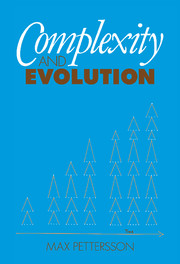Book contents
- Frontmatter
- Contents
- Foreword by Joseph Needham, FRS
- Preface
- Acknowledgements
- 1 Natural and other hierarchies
- 2 Major integrative levels
- 3 Some logarithmic forms of display
- 4 Physical range of integrated natural entities
- 5 Biological range of integrated natural entities (first part)
- 6 Biological range of integrated natural entities (second part)
- 7 Social range of integrated natural entities
- 8 Human societies (first part)
- 9 Human societies (second part)
- 10 Acceleration in evolution
- 11 Further allied accelerations
- 12 Aspects of number
- 13 Aspects of mass
- 14 Positive skewness
- 15 Quantitative conclusions
- Bibliography
- Index
11 - Further allied accelerations
Published online by Cambridge University Press: 18 January 2010
- Frontmatter
- Contents
- Foreword by Joseph Needham, FRS
- Preface
- Acknowledgements
- 1 Natural and other hierarchies
- 2 Major integrative levels
- 3 Some logarithmic forms of display
- 4 Physical range of integrated natural entities
- 5 Biological range of integrated natural entities (first part)
- 6 Biological range of integrated natural entities (second part)
- 7 Social range of integrated natural entities
- 8 Human societies (first part)
- 9 Human societies (second part)
- 10 Acceleration in evolution
- 11 Further allied accelerations
- 12 Aspects of number
- 13 Aspects of mass
- 14 Positive skewness
- 15 Quantitative conclusions
- Bibliography
- Index
Summary
As our ancestors and others ascended the natural hierarchy, from Level 4 to Level 9, there was acceleration, as established in Chapter 10. It will now be interesting to try and relate this newly discovered evolutionary acceleration to two other forms of acceleration about which a number of studies have already been published.
One refers both to acceleration in the increase of the number of humans on Earth and to acceleration in human cultural innovation. It will be found that a coherent picture does emerge, leading to what may be called ‘the law of ever faster change’. The topics of demographic increase and cultural innovation stand somewhat apart from our central study of the natural hierarchy. But it does seem worthwhile to notice these processes, if only briefly.
The difficulties resulting from the increasing numbers of people are force-fully discussed by, for instance, Parsons, (1971) and Ehrlich and colleagues (e.g. 1970, 1978), while another American writer, Toffler (1971), provides a moving and well-documented account of the increasing rapidity of social change.
Method of plotting
Figures 11.1 – 11.3 all use the same special axes, which have been found convenient for the data under consideration. The horizontal axis is a logarithmic scale of chronological time, referring to the number of years before AD 2000. Thus the five markers on the right of the horizontal axis refer to the dates 1999, 1990, 1900, AD 1000 and to 8000 BC.
Information
- Type
- Chapter
- Information
- Complexity and Evolution , pp. 98 - 106Publisher: Cambridge University PressPrint publication year: 1996
